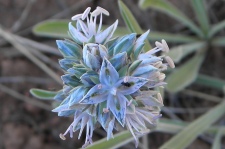 On Wednesday I was out at Gray’s Valley, along Highway 44, to collect grass seed. Specifically, I was after a huge stand of Idaho fescue (Festuca idahoensis) that I had been checking vigilantly every week. Normally we harvest high-elevation grass seed around the end of July or very beginning of August. This wacky year, however, grasses are very late but flowering profusely. They must be harvested after the seed has hardened but before the seeds drop from the plant to the ground. We managed to hit it just right, and spent several hours collecting seed. This seed will be cleaned and sent to a nursery, where over the course of a few years our pound or so of wild seed will be increased to several hundred pounds of native, locally adapted fescue.
On Wednesday I was out at Gray’s Valley, along Highway 44, to collect grass seed. Specifically, I was after a huge stand of Idaho fescue (Festuca idahoensis) that I had been checking vigilantly every week. Normally we harvest high-elevation grass seed around the end of July or very beginning of August. This wacky year, however, grasses are very late but flowering profusely. They must be harvested after the seed has hardened but before the seeds drop from the plant to the ground. We managed to hit it just right, and spent several hours collecting seed. This seed will be cleaned and sent to a nursery, where over the course of a few years our pound or so of wild seed will be increased to several hundred pounds of native, locally adapted fescue.
The fescue stand occurred in an open flat among sagebrush (Artemisia tridentata), goldenbush (Ericameria bloomeri), and bitterbrush (Purshia tridentata). Most of the forbs were long gone, with the exception of a broom-rape (Orobanche corymbosa) that I will post later. The fescue is an easily recognized bunchgrass with dense tufts of blue-green, needle-like leaves. This time of year, it looks about like this. It is common across our eastside pine forests and we are happy when we can have seed available for restoration projects.

